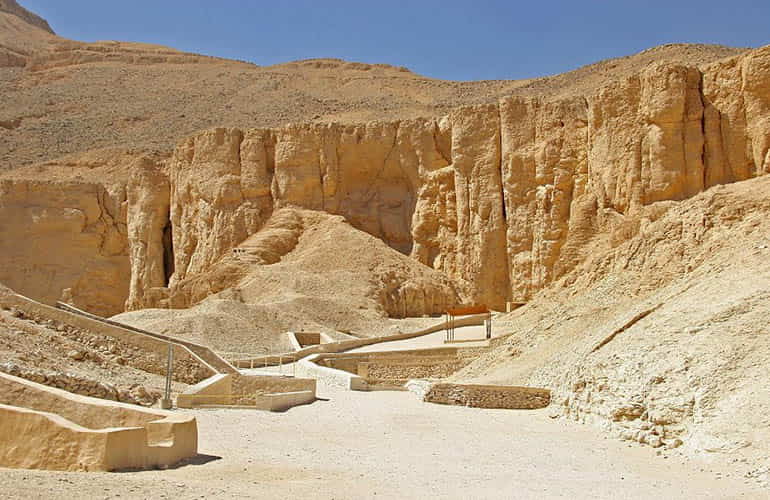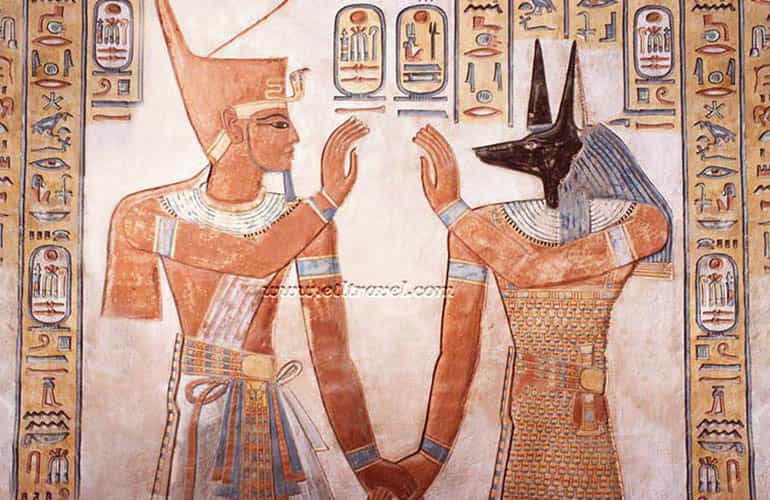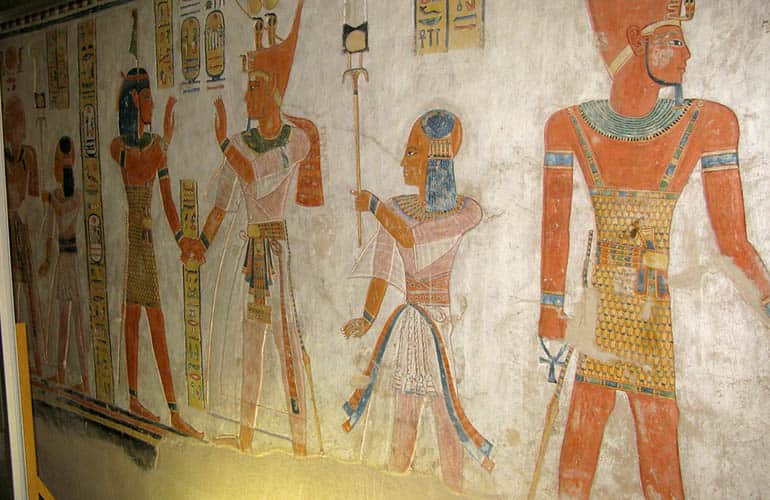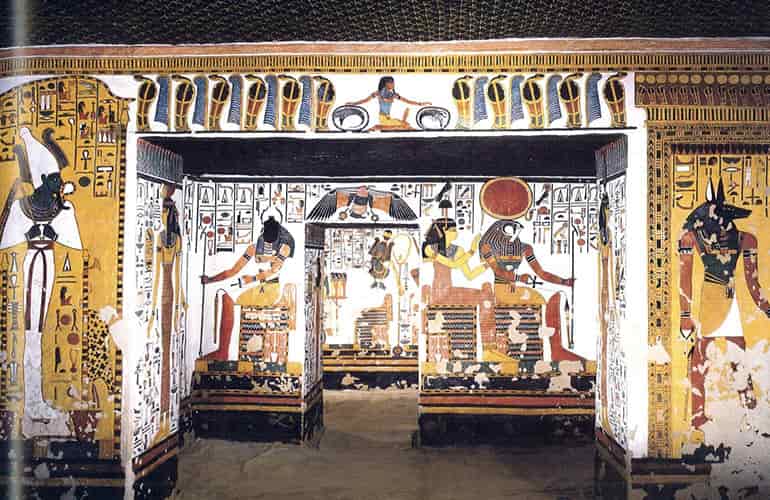Valley Of The Queens facts:
Named by Champollion, the Valley of the Queens lies to the southwest of the Valley of the Kings and holds the tombs of many royal wives and children. Although it was used as a burial site in the 18th Dynasty, it was only from the reign of the 19th-Dynasty pharaoh Ramses I that royal wives were laid to rest here. Of the nearly 80 tombs populating the valley, the most famous is that of Queen Nefertari [ Read more about Ancient Egyptian pharaohs ] and only a handful are open to the public at any one time.

Valley of the Queens location:
The Valley of the Queens is located in the city of Luxor, on the west bank of the Nile River and is part of a group of cemeteries called Old Thebes and its necropolis, along with the Valley of the Kings.
Valley of the Queens Features:
Tomb of Amunherkhepshep
The elegant, well-preserved tomb of Prince Amunherkhepshep (Amun), son of Ramses III, was the highlight of the Valley of the Queens until the reopening of Nefertari’s tomb. Amun would have succeeded his father as a pharaoh but he died when he was a child and was buried in this royal tomb.
From the entrance, steps lead down to the tomb hall, which contains beautiful, brightly-colored wall paintings of Ramses accompanying his young son on a visit to pay homage to the gods of the underworld.
Amun is easily recognizable because he is wearing the characteristic braided hairstyle of a prince. a corridor decorated with the Keepers of the Gates leads to the burial chamber, where the skeleton of a five-month-old foetus is on display in a glass cabinet. Foetuses have been found in other burial chambers and may have been placed there as part of the ritual of rebirth.

Tanedjemet
Although archaeologists and Egyptologists have shed a lot of light on ancient Egypt, the truth is that in many cases it remains a real mystery. It is not unusual for them to find hidden places, strange scrolls or even unknown tombs of unknown people from time to time, which alter a little the order of the kings and queens of the dynasties.
This is the case of Tanedjemet, a princess and queen who is believed to have lived in the 19th dynasty, although even that fact cannot be corroborated.
This name was totally unknown until they found a small tomb in the Valley of the Queens. The tomb QV33. There was absolutely no document or representation of this mysterious woman, nothing that could help the Egyptologists locate the mummy in a specific period. For this reason, it was initially believed to date to the 20th Dynasty, although in the end, they have opted for the 19th Dynasty.
Its name seemed to indicate that it could be the daughter of Horemheb, the last pharaoh of the Eighteenth Dynasty of Egypt fruit of his union with the Great Royal Wife the queen Mutnedjmet. If these data are true, since they are only hypotheses, Tanedyemy would have played a fundamental role in the dynastic change, since she would have married a pharaoh of the following dynasty.
This would be due to the fact that her father did not have any male children. So the change of throne could only be done through his vizier, Ramesses I. Although a king could easily designate his successor, the truth is that in the relationship between the two there must be some family relationship. For this reason, it was not strange that in these circumstances, the selected man married one of the daughters of the Pharaoh.
The problem is that although in his tomb you can see that he held the title of Great Royal Wife, the truth is that Ramses I was too old to be able to bring up offspring, besides, he is only known by his wife Sitra, his lifelong wife.
Thus, it could be that Tanedyemy, instead of marrying Ramses I did with his son, Sethy I.
Once again the passage of time becomes insurmountable in order to shed some light on this story, which, like many others, rests for centuries in the tomb-strewn valleys of ancient Egypt.
Tomb of Khaemweset in the Valley of the Queens
The Tomb of Khaemwese, one of the sons of Ramesses III, is the number QV 44 in the Valley of the Queens on the west bank of Luxor -former Thebes It was discovered in the early 20th century, with a large number of sarcophagi piled up in the entrance corridor. This was a clear sign that it had been used for common burial.
Khaemweset had among its most important roles, that of Priest of Ptah in Memphis. His important titles were “Sem Priest” as indicated by reliefs in the Temple of Medinet Habu.
He was probably the eldest son of Ramesses III, and the most recent information indicates that his mother was probably Queen Tyti, but it is unknown because he did not ascend to the throne; Khaemweset probably did not die during the reign of Ramses III, but later during that of his brother, Ramesses IV
The walls of the tomb have decorations in low relief, the painted colors remain in exceptional conditions and are very elegant. This tomb follows a straight axis with a descending entrance corridor leading to the first main hall and a vestibule. Upon entering the vestibule, on the left is an image of Ptah followed by a scene of Ramesses III and Khaemwaset in front of Anubis and Re Harajty. On the right wall of this room is the king, carrying offerings to Ptah-Sokar along with a representation of him and Khaemwaset presenting Geb with incense offerings before being received by the god Shu.
From here, one enters the burial chamber, the first thing one finds is chapters 145 to 146 on the left of the Book of the Dead. Another scene shows Ramses III, followed by the prince, and several scenes of the geniuses who guarded the gates of the kingdom of Osiris.

The tomb of Nefertari
The tomb of Nefertari is located in the Valley of the Queens, in Luxor, is of great beauty, worthy of its position in history. The motifs on the walls and ceilings are mythological and deal with life in the underworld, the meetings with the gods, deities, genies and monsters and the entrance to the kingdom of eternity.
Nefertari is depicted dressed in white, wearing a golden vulture headdress with two long feathers and is adorned with valuable jewelry such as bracelets and a wide gold necklace.
At the entrance door to the tomb, Isis and Nephthys appear in the form of a falcon on the left and Nejbet and Wadjet are represented on the right.

The outer hall is square in shape, with a bench to support the funeral’s trousseau, above which is an inscription from the Book of the Dead and various scenes.
On the left, the Queen appears on a throne, holding in her right hand a kind of magic wand. In another of the scenes represented, a bird with the Queen’s head appears, it is the Egyptian representation of the individual soul.
In the scene the Queen appears kneeling, with her hands raised in adoration towards two lions, where the solar disk appears between them, the lions represent the past and the future, the bird “Benu”, represents the sacred bird of Heliopolis.
The sanctuary is flanked by representations of the two goddesses Isis and Nephthys, where scenes appear with a coffin in the centre containing a jackal, surrounded by mummy figures.
On the west wall there are images, where Nefertari appears showing his respects to the god Thot, on his left side there is a large text from the Book of the Dead.
From the outer hall, one enters the corridor that leads to the tomb, where it appears beautifully decorated and the upper parts of the corridors are organized in the same way, where Nefertari offers two bowls of milk to the goddess Isis and Hathor.
This corridor leads to the tomb, after the end of the funeral ceremony and where the final transition to the burial chamber takes place.
The burial chamber is a large rectangular room with four large pillars, on one side are two rooms and a small interior room, whose function is unknown
The walls of the entrance to the burial chamber are decorated with four goddesses and texts from the Book of the Dead. On one of the walls of the room, Nefertari appears in the form of a mummy.






